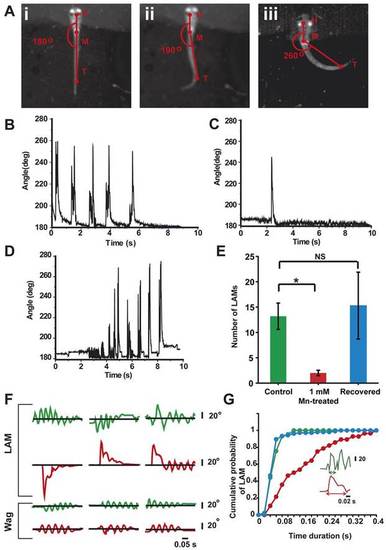
Altered frequency and duration of trunk movements in Mn-exposed larvae. (A) Still frames from a 20-second movie recorded at 300 fps in a head-embedded larva. The angle between head ‘H’, mid trunk ‘M’ and tail ‘T’ was used as a measure of the extent of trunk movement when the larva was exhibiting (i) a resting state (180°), (ii) wagging (<200°, supplementary material Movie 2) and (iii) large-angle movements (LAM) (>200°, supplementary material Movies 3, 4). The trunk movement angle plotted against time for (B) control larvae, (C) Mn-treated (48-hour exposure to 1 mM MnCl2) and (D) recovered (24-hour recovery following Mn exposure) larvae. (E) Average number of LAMs within a 20-second period plotted for control (n=5), Mn-treated (n=7) and recovered (n=7) larvae. Error bars indicate s.e.m. Statistical analysis was performed by using Wilcoxon rank sum test with Bonferroni correction for multiple comparisons. *P=0.0025; NS, non significant. (F) Stacks of expanded plots of LAMs and short wags in control (green) and Mn-exposed larvae (red). The black line represents the resting position. Angles above the line depict left-directed movements and angles below the line depict right-directed movements. Alternate consecutive left and right LAM patterns, and clusters of unidirectional LAMs were observed in control larvae, whereas Mn-exposed larvae exhibited single LAMs which were not immediately followed by other LAMs. (G) Cumulative probability distribution of LAM durations for control (green), Mn-treated (48-hour exposure, red) and recovered (24 hours in Mn-free medium following Mn exposure, blue) larvae indicating that control and recovered larvae displayed shorter duration LAMs, whereas Mn-treated larvae displayed longer duration LAMs (P<0.0001). Statistical analysis was performed using Kruskal–Wallis ANOVA.
|

